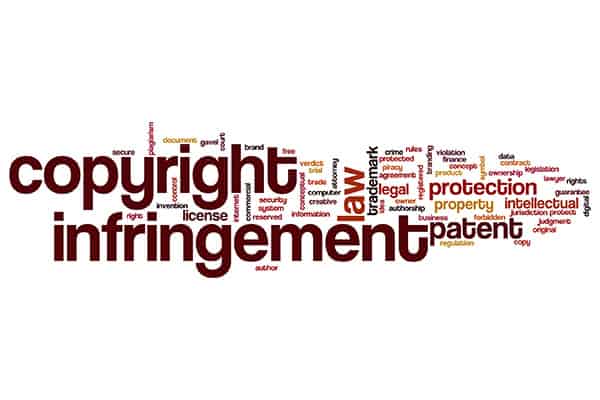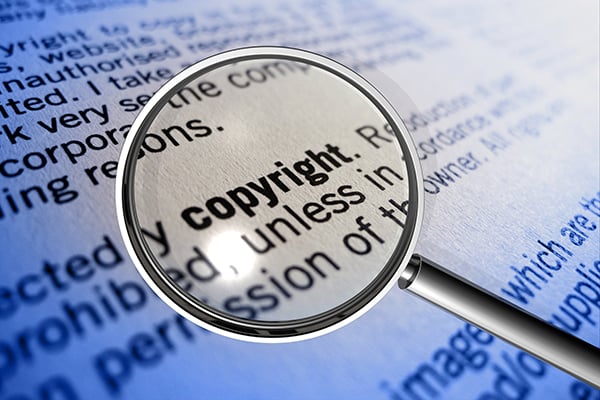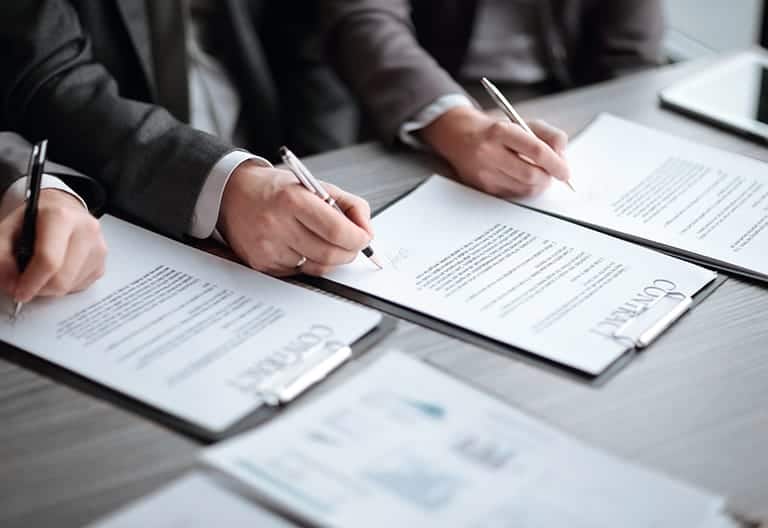
How you can protect your intellectual property and copyright
Posted on 11th February 2022 by Phil Ainley
As a self-employed business owner, freelancer or contractor, it’s important to understand what intellectual property and copyright is and how you can protect yours.
Protecting your intellectual property and copyright can make it easier for you to take legal action someone if they try exploits yours. An example can include if someone copies your logo or plagiarises an original article that you’ve written.
What is intellectual property?
Intellectual property is intangible personal property that you create using your mind. This is usually a collection of ideas and information in a broadly commercial context that the law recognises as having a value, such as a story or an artistic design.
Intellectual property covers:
- Copyright
- Designs
- Passing off
- Trademarks
- Patents

Why do you need intellectual property protection when self-employed?
Intellectual property protection is designed to deter others from infringing your intellectual property rights, e.g.: copying your work for their own commercial purposes. The law allows you to seek a court order to stop the infringement and to pursue legal proceedings for monetary damages.
As a self-employed professional you own the intellectual property of the work you produce for clients, unless you have agreed in your contract (generally in writing) to give your client the rights. Therefore it’s up to you to make sure your intellectual property is protected.
In contrast, as an employee of a company your employer will own the intellectual property of the work you created for the company while employed by them.
Some types of intellectual property protection, such as copyright, apply automatically. For others, including trademarks, you will need to apply for protection.
How can I obtain copyright protection for my work?
Copyright protection is automatic and free and protects your work and prevents others from using it or copying it without your consent.
Copyright applies automatically to the creation of:
- Original literary, dramatic, musical and artistic work, including illustrations and photography
- Original non-literary written work, such as the creation of software, web content and databases
- Sound and music recordings
- Film and television recordings
- Broadcasts
- The layout of published editions of written, dramatic and musical works (1).
For example, a unique business logo design will be protected by copyright as it is considered to be original artistic work. Copyright protects the expression of an idea, rather than the idea itself.
You can mark your work with the copyright symbol ©, your name and the year of creation. Whether you mark your work or not does not affect your level of copyright protection (2).
The length for which copyright applies depends on the type of work. For example, published editions of written, dramatics and musical works are copyright protected for 25 years. For written, dramatic, musical and artistic work, copyright lasts 70 years after the author’s death (3).
To gain copyright protection, you will need to prove your right to the copyright. You achieve this by having signed and dated copies of your designs approved and held by a solicitor.
With regards to overseas copyright, in most countries copyright lasts a minimum of life plus 50 years for most types of written, dramatic and artistic pieces of work, and at least 25 years for photographs. The length of time copyright lasts can be different for other types of work, so it is a good idea to check (2).
Contact the IPO Information Centre if you have a question about international copyright – Email: information@ipo.gov.uk – Tel: 0300 300 2000. The IPO Information Centre is open Monday to Friday, 9am to 5pm.
How can I protect my designs from copyright infringement?
If you’re a designer, certain types of designs are automatically protected without needing to register anything, under the protection. The design must have an original shape or configuration, as such 2-dimensional shapes such as textiles, graphics or wallpaper are excluded. The design must not be commonplace, therefore designs that are well known, mundane or routine are also excluded.
These unregistered designs last for 10 years from the date of first marketing the article in the UK, or 15 years from creation of the design, whichever is earliest. This will prevent others from being able to use your designs without your permission.
Again, to gain this protection, you will need to prove your right, for example, by having signed and dated copies of your design drawings approved and held by a solicitor. Alternatively, you may wish to apply for a ‘registered design’, which is discussed in more detail later on in this article.
Understanding what ‘Passing Off’ is
Passing off happens when someone deliberately or unintentionally passes their goods or services as belonging to another party. This type of action can damage the reputation of a business or person and can cause significant financial damage.
The passing off law helps to protect the trader against unfair competition from their rivals and also protects consumers who could be confused as to the origins of goods and services they are offered.
To bring a successful passing off action you must show three things:
- That goodwill or reputation is attached to your goods or services.
- A misrepresentation is made to the public by the defendant.
- You have suffered damage.
Passing off law is complicated and claims can be difficult to prove, meaning that claims action can be expensive as the burden of proof is that of the trademark owner. It is only the trader who can take passing off action if there is wrongdoing and action can only be taken against a defendant who is also engaged in trading.
Examples of defences that you might encounter should you pursue a claim can include:
- the mark in question is not distinctive
- the mark is generic
- they have used carefully and honestly their own name
- you don’t have goodwill in the mark
- you have given consent or encouraged the use of the mark
- you can’t demonstrate damage or loss (4)
As with copyright and design rights, you do not need to formally register anything to make a claim that someone is passing off their goods or services as yours.
Passing off can be seen as a form of protection for business brand names and logos in situations where they don’t have a registered trademark.
Which intellectual property protection requires registration?
Trademarks, registered designs and patents all require you to apply and pay for protection.
What is a trademark?
A trademark is a mark, brand or sign used by traders to differentiate their goods from those of other traders, such as a logo or business brand name.
Other examples of trademarks include:
- Labels
- Words
- Domain names
- Packaging
- Smells
- Sounds, such as jingles
- Shape of certain goods
- Other distinguishable features
For a trademark to be protected it must be registered, otherwise you will need to rely on the law of copyright and/or passing off for protection.
What’s the difference between copyright protection and trademark protection?
Copyright typically protects the original artist of the work. Trademark registration usually protects the brand or organisation who registered the trademark.
While copyright infringement is more concerned with the unauthorised use of someone else’s work, trademark infringement is concerned with misuse of specific registered trademarks, such as brand names and logos and which causes damage to the brand in question, takes advantage of its reputation or causes confusion to consumers (5).
I think someone has breached my copyright, what should I do?
If you believe someone has breached your copyright or infringed on your intellectual property, it is your responsibility to take action.
In the first instance, it is advisable to seek legal advice from an intellectual property professional, such as a solicitor. They’ll be able to advise you on the best course of action.
As a Caunce O’Hara legal expenses insurance customer you have access to the Markel Law Hub, which offers free access to a 24-hour legal advice helpline – providing you with access to an experienced team of qualified solicitors. Knowing who to turn to for expert legal advice can be difficult when you’re working for yourself.
Registered designs
If you’ve designed a business asset such as a logo or product, you might want to have the look of your design registered to prevent others from stealing or copying it. This can include the appearance, physical shape, configuration or decoration of your design.
Registering your design gives you the right to stop others from using your design for up to 25 years although you will need to renew your design registration every 5 years.
Certain designs are automatically protected, but getting them registered makes taking legal action against infringement and copying easier as well as helping to protect your design for longer.
Patents
A patent protects something you have invented. If someone makes, uses, sells or imports your invention without your approval, a patent enables you to take legal action against them.
In order to get a patent for your invention, it needs to be all of the following:
- New
- Something that can be made or used
- Inventive – not just a simple modification to something that already exists.
Patents cannot be gained for things like literary or artistic works and are often difficult to obtain as well as being costly to apply for.
How can I register a trademark, design or patent?
To get a registered trademark, design or patent, you need to apply for registration through the , which you will need to pay for.
Though it comes at a cost, having this protection in place can be invaluable for some businesses.
Caunce O’Hara clients who have a legal expenses insurance policy with us also have access to the online . There you’ll find more guidance on how to register your intellectual property in the UK and beyond, plus more guidance generally on the areas discussed in this article.
The Markel Law Hub is an online resource of over 1,300 legal and business guides, templates and content written and created by a team of expert solicitors and other experts where you can download contract templates, policies, procedures and guidance you can use to run your business with confidence and potentially save money on expensive legal fees.
Can you use more than one type of intellectual property protection on the same piece of work?
The different types of intellectual property protection discussed in this article overlap. GOV.UK use a good example on their website of how the different types of protection can work together to protect a single product:
- Register the name and logo as a trademark
- Protect a product’s unique shape as a registered design
- Patent a completely new working part
- Use copyright to protect drawings of the product (6).
What happens if I accidentally breach copyright law?
Unintentional breach of copyright is increasingly common and an easy error to make.
For example, if you use an image on your website or on your social media channels, with no credits, that despite being from a stock image library had some small print terms and conditions stating that you have to provide photo credit with the image, or that the image cannot be used for advertising purposes, then you could be faced with a breach of copyright claim.
If the copyright owner’s claim is successful, you could be left paying compensation plus legal costs. Carrying professional indemnity insurance in these situations can prevent you from having to pay these costs out of your own pocket.
Professional indemnity insurance from Caunce O’Hara can cover the costs of unintentional infringement of intellectual property rights. To find out more about professional indemnity insurance, click here.
Sources:
- Markel Law Hub
- https://www.gov.uk/copyright
- https://www.gov.uk/copyright/how-long-copyright-lasts
- https://www.nibusinessinfo.co.uk/content/passing-definition-remedies-and-defences
- https://www.gov.uk/guidance/intellectual-property-crime-and-infringement#dealing-with-infringement
- https://www.gov.uk/intellectual-property-an-overview/protect-your-intellectual-property
https://www.gov.uk/unregistered-designs
https://copyrightservice.co.uk/protect/p15_design_rights
Useful Links

Professional Indemnity Insurance
Protects against claims of alleged negligence in your professional services, advice and designs.

Commercial Crime Cover
Protection for losses from, fraud, dishonesty, theft, bribery, forgery, and loss investigations.

Cyber Insurance
Covers your business in the event of a malicious attack on your computer systems and data.
